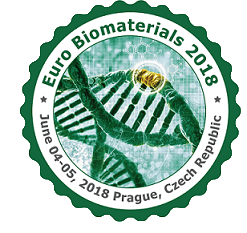
Jeasung Park
Korea Institute of Industrial Technology, korea
Title: Synthesis and cross-linking of hydrogen and vinyl dimethicones for artificial secondary skin
Biography
Biography: Jeasung Park
Abstract
We report the synthesis and application of cross-linked silicones between hydrogen and vinyl dimethicones which are base materials for artificial secondary skin in order to hide old and wrinkled skin. Hydrogen dimethicones were synthesized by ring-opening polymerization of 1,1,3,3,5,5,7,7-octamethylcyclotetrasiloxane (D4) and 1,3,5,7-tetramethylcyclotetrasiloxane (D4H) in the presence of trifric acid as an acidic catalyst and hexamethyldisiloxane as an end capping agent. The initial molar ratios of D4 and D4H before reaction were 50:50, 70:30, 80:20 and 90:10 and the resulting molar ratios ended up with 55:45, 75:25, 85:15 and 94:6, respectively, confirmed by 1H-NMR. Gel permeation chromatography results showed that the polymers are monodispersed with ~1.8 PDI. Vinyl termainated dimethicones were also prepared by functionalization of dihydroxyl terminated dimethicones which had been synthiszed from octamethylcyclotetrasiloxane through ring-opening polymerization. The vinyl functionalization was performed in the presence of dichloromethane as a solvent and dimethylvinylcholorosilane as a vinyl end capping agent. The final products exhibited 11,300-13,500 of Mn, 38,900-67,900 of Mw and 3,43-5.03 of PDI values, which are depending on the molar amount of H2O. Cross-linked silicone materials for artificial secondary skins were fabricated by mixing the hydrogen and the vinyl dimthicones with Karstedt catalyst. Their tensile modulus and toughness are not sufficiently high for artificial skin application. In order to improve the mechanical properties, a fumed silica (Aerosil 200, 2.5 part based on the weight of the dimethicone mixture) was added to dimethicone mixture before adding the cross-linking catalyst. The tensile modulus and the elongation were enhanced by approximately 5-fold and 2-fold, respectively.

